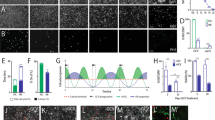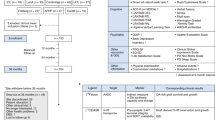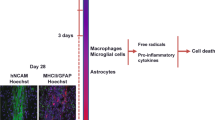Abstract
Two subjects with Parkinson's disease who had long-term survival of transplanted fetal mesencephalic dopaminergic neurons (11–16 years) developed α-synuclein–positive Lewy bodies in grafted neurons. Our observation has key implications for understanding Parkinson's pathogenesis by providing the first evidence, to our knowledge, that the disease can propagate from host to graft cells. However, available data suggest that the majority of grafted cells are functionally unimpaired after a decade, and recipients can still experience long-term symptomatic relief.
This is a preview of subscription content, access via your institution
Access options
Subscribe to this journal
Receive 12 print issues and online access
$209.00 per year
only $17.42 per issue
Buy this article
- Purchase on Springer Link
- Instant access to full article PDF
Prices may be subject to local taxes which are calculated during checkout


Similar content being viewed by others
References
Olanow, C.W. et al. Ann. Neurol. 54, 403–414 (2003).
Freed, C.R. et al. N. Engl. J. Med. 344, 710–719 (2001).
Björklund, A. et al. Lancet Neurol. 2, 437–445 (2003).
Piccini, P. et al. Nat. Neurosci. 2, 1137–1140 (1999).
Mendez, I. et al. Brain 128, 1498–1510 (2005).
Hagell, P. et al. Brain 122, 1121–1132 (1999).
Kordower, J.H. & Sortwell, C.E. Prog. Brain Res. 127, 333–344 (2000).
Chu, Y. & Kordower, J.H. Neurobiol. Dis. 25, 134–149 (2007).
Anderson, J.P. et al. J. Biol. Chem. 281, 29739–29752 (2006).
Doucet, G. et al. Exp. Neurol. 106, 1–19 (1989).
Vila, M. et al. J. Neurochem. 74, 721–729 (2000).
Mogi, M. et al. Neurosci. Lett. 270, 45–48 (1999).
Sigurdsson, E.M., Wisniewski, T. & Frangione, B. Trends Mol. Med. 8, 411–413 (2002).
Braak, H. et al. Neurobiol. Aging 24, 197–211 (2003).
Meyer-Luehmann, M. et al. Science 313, 1781–1784 (2006).
Hardy, J. Biochem. Soc. Trans. 33, 578–581 (2005).
Acknowledgements
This work was supported by grants from the Swedish Research Council, Swedish Parkinson Foundation, the Nordic Center of Excellence on Neurodegeneration and The Strong Research Environment of the Swedish Research Council (NeuroFortis). The Queen Square Brain Bank is supported by the Reta Lila Weston Institute of Neurological Studies and the Progressive Supranuclear Palsy (Europe) Association. T.R. and J.L.H. are supported by grants from the Parkinson's Disease Society, UK, the Alzheimer's Research Trust and the Sarah Matheson Trust. The authors wish to thank B.-M. Lindberg and A. Persson for their excellent technical support. E.E. and J.L.H. contributed equally as the second authors.
Author information
Authors and Affiliations
Contributions
J.-Y.L. designed and performed the detailed morphological analysis of most of the material from subject 3. E.E. and J.L.H. did autopsy and routine neuropathology of subjects 3 and 8, respectively. J.L.H. and T.R. designed and T.L. performed the detailed morphological analysis of subject 8. A.B. provided expertise in neural transplantation. D.S. provided expertise regarding graft reconstruction, imaging and microglia staining and also generated figures. P.H. assisted in the care of subject 3 and provided data related to clinical follow-up. H.W. and N.P.Q. took care of subjects 3 and 8, respectively. A.J.L. provided clinical evaluation for subject 8. S.R. operated on both subjects. P.B. dissected and prepared tissue for both surgeries and participated in the morphological assessment of subject 3. O.L. took care of subject 3 and headed the clinical transplantation program. J.-Y.L., J.L.H., T.R., O.L. and P.B. wrote the manuscript. All authors gave input to the manuscript.
Corresponding author
Supplementary information
Supplementary Text and Figures
Supplementary Figs. 1–4 and Supplementary Methods (PDF 1832 kb)
Rights and permissions
About this article
Cite this article
Li, JY., Englund, E., Holton, J. et al. Lewy bodies in grafted neurons in subjects with Parkinson's disease suggest host-to-graft disease propagation. Nat Med 14, 501–503 (2008). https://doi.org/10.1038/nm1746
Received:
Accepted:
Published:
Issue Date:
DOI: https://doi.org/10.1038/nm1746
This article is cited by
-
Cell-therapy for Parkinson’s disease: a systematic review and meta-analysis
Journal of Translational Medicine (2023)
-
Challenges in the clinical advancement of cell therapies for Parkinson’s disease
Nature Biomedical Engineering (2023)
-
AAV-mediated expression of a new conformational anti-aggregated α-synuclein antibody prolongs survival in a genetic model of α-synucleinopathies
npj Parkinson's Disease (2023)
-
Tunnelling nanotubes between neuronal and microglial cells allow bi-directional transfer of α-Synuclein and mitochondria
Cell Death & Disease (2023)
-
Association of Glial Activation and α-Synuclein Pathology in Parkinson’s Disease
Neuroscience Bulletin (2023)



